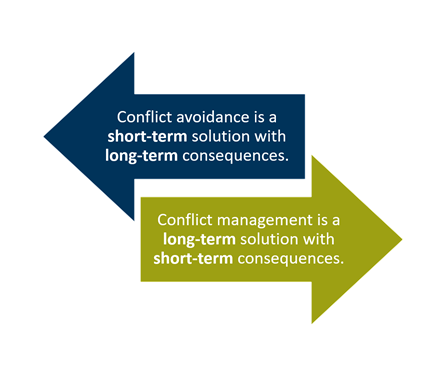Avoiding Conflict at Work
Do You Avoid Conflict?
Conflict is inevitable, especially at work. The nature of the workplace requires that we cooperate with others to achieve our goals and this means we can often end up butting heads. For many of us, our impulse is to ignore problems, avoiding conflict and hoping it goes away. We don’t want to rock the boat, we don’t want to experience the uncomfortable emotions that accompany conflict, and we don’t want to damage our relationships. This is known as conflict avoidance.
However, conflict can have positive outcomes if we foster a team environment that can engage with conflict constructively. Under the right circumstances, we can reduce the negative impacts of conflict, enhance its positive effects on productivity, and strengthen the bonds between team members. For example, in teams with high levels of trust, where team members feel safe to share ideas and opinions that go against the grain, conflict can improve decision-making[i].
Sometimes, our impulse to avoid conflict can be helpful in getting past trivial issues or by giving us the time we need for our emotions to cool down[ii]. Yet, in general, we engage in conflict avoidance too often, without realizing that the long-term consequences are often worse than the negative emotions and potential risk to our social ties, and can seriously harm a team’s performance[iii].
“Leaders do not avoid, repress, or deny conflict, but rather see it as an opportunity” – Warren Bennis
What Does Conflict Avoidance Look Like?
People may employ different conflict avoidance strategies depending on their personality and the situation. Keep an eye out for these kinds of behaviors to identify if you’re engaging in conflict avoidance:
Changing the Subject
When asked about issues that generate uncomfortable feelings, we may avoid the issue by side-stepping it. We might answer a different question, derail the conversation with an unrelated concern or question, or otherwise divert attention from the issue.
Denying the Issue
Rather than acknowledging that there is an issue, we might suppress our emotions and act as though the issue is not bothering us. This might also take the form of reluctantly agreeing to another person’s plan, despite having opposing ideas.
Withdrawing or Stonewalling
Another conflict avoidance technique is to disengage, emotionally or physically, from conversations or situations where conflict may arise. We might refuse to talk or engage with anything relating to the conflict.

Breaking the Cycle: Managing Conflict
Conflict generates uncomfortable or unpleasant feelings, such as anxiety. Therefore, avoiding conflict brings us relief, a comparatively pleasant feeling. This means that when conflict resurfaces, we want to steer clear of it, so we can avoid negative emotions and enjoy relief. This can be a difficult cycle to break, but it means that rather than becoming comfortable with conflict and skilled in managing it, we’ve guaranteed we’ll always experience the unpleasant feelings that come with it. Ultimately, avoiding conflict is like sweeping dirt under a rug: it hides it, but leaves the problem unresolved.
Mindfulness can be a powerful tool in helping us learn to manage conflict. A mindful approach to conflict can help us reduce the occurrence of conflict and buffer against negative outcomes when it does happen[iv]. In addition, mindfulness training can improve our ability to manage stressful situations by allowing us to “sit with” or accept unpleasant emotions without being overwhelmed by them. Similarly, developing our emotional intelligence can help us better manage our emotions so that we do not need to rely on avoiding conflict to cool down.
Remember that conflict can be productive when it is isolated to the task at hand and does
not become personal or emotionally heated. Successful leaders learn how to
manage conflict constructively and foster team environments where disagreements
can lead to innovative strategies and appreciation for the perspectives of
other team members. Leaders with better approaches to conflict also pass down
the right ways to handle conflict to future leaders in their teams,
contributing to more successful work environments across the organization.
How SIGMA Can Help
At SIGMA, we can help you manage conflict mindfully. Check out our mindfulness offerings, including our webinar, workshops, and one-on-one coaching services. Contact us for more information on how mindfulness training can help your team effectively manage conflict.
[i] Bradley, B. H., Postlethwaite, B. E., Klotz, A. C., Hamdani, M. R., & Brown, K. G. (2012). Reaping the benefits of task conflict in teams: The critical role of team psychological safety climate. Journal of Applied Psychology, 97, 151-158. doi:10.1037/a0024200.
[ii] Edmondson, A. C., & Smith, D. M. (2006). Too hot to handle? How to manage relationship conflict. California Management Review, 49, 6-31. doi:10.2307/41166369
[iii] O’Neill, T. A., Allen, N. J., & Hastings, S. E. (2013). Examining the “Pros” and “Cons” of team conflict: A team-level meta-analysis of task, relationship, and process conflict. Human Performance, 26, 236-260. doi:10.1080/08959285.2013.795573
[iv] Yu, L., & Zellmer-Bruhn, M. (2018). Introducing team mindfulness and considering its safeguard role against conflict transformation and social undermining. Academy of Management Journal, 61, 324-347. doi:10.5465/amj.2016.0094